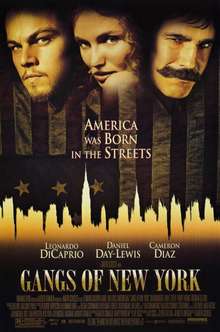Have you ever noticed that some actors seem to be in every critically-acclaimed movie? I’m not talking about the actors who win a lot of awards, but then also do some “low brow” comedies on the side. I’m referring to the actors who just seem to have a higher standard for the work they do. They usually aren’t the most prolific actors, but often they are the most-awarded actors. It’s almost as if they have perfected the craft of acting and will only take on roles they know will bring them the praise of critics and audiences alike. Daniel Day-Lewis certainly seems to fit into this category of actors. While he has appeared in more films in the early part of his career, lately his roles have been a little more spread out, but have earned him many accolades, regardless. This week’s two films highlight some of Daniel Day-Lewis’ most notable roles.
Gangs of New York
Year: 2002
Rating: R
Length: 167 minutes / 2.78 hours
Even though Daniel Day-Lewis has won multiple Oscars, there are still a few films where he was nominated for Best Actor and didn’t win the honor. It’s probably useful to note that these films were also nominated for Best Picture, but also lost to other movies. His first loss was to Tom Hanks in 1993 (for Hanks’ role in Philadelphia), despite a solid performance in In the Name of the Father (which itself lost to Schindler’s List). Fortunately, the only other time he didn’t win a nomination was in 2002 for his role in Gangs of New York (losing to Adrien Brody in The Pianist and the film losing to Chicago). Of course, Gangs of New York also garnered Martin Scorsese a nomination for Best Director. The only other time Day-Lewis and Scorsese worked together was for the period piece, The Age of Innocence (1993).
In Gangs of New York, Daniel Day-Lewis portrays William “Bill the Butcher” Cutting, a man whose violent tendencies crushed a rival gang of Irish immigrants led by a Catholic priest (Liam Neeson). Having no trouble cutting up animals or men, his intimidating persona managed to keep the neighborhoods of lower Manhattan in a state of fearful peace for 16 years. Amid the Civil War, a man by the name of Amsterdam (Leonardo DiCaprio) arrives in New York and starts to stir up some trouble, becoming involved with William M. Tweed (Jim Broadbent), the boss of the newest rival gang to Bill’s “Natives.” As it turns out, Amsterdam has a connection to the previous gang war, and it doesn’t take long for Bill to figure out who he was related to. Instead of running away to San Francisco, Amsterdam officially challenges Bill to a fight, which he accepts to his own peril.
Lincoln
Year: 2012
Rating: PG-13
Length: 150 minutes / 2.5 hours
No other actor has won three Best Actor Oscars. Walter Brennan won three Best Supporting Actor statues, but everyone knows the highest honor comes with Best Actor. Daniel Day-Lewis has achieved this feat with only five nominations to his name. Even before he won his first Best Actor Oscar, he appeared in the Best Picture, Gandhi (1982). He would then go on to win his acting Oscars in the Best Picture nominees, My Left Foot (1989), There Will Be Blood (2007), and Lincoln (2012). Perhaps due to his first Oscar coming from My Left Foot, Day-Lewis collaborated with director Jim Sheridan twice more for In the Name of the Father (which earned him an aforementioned acting nomination) and The Boxer (1997). Still, it’s his performance in Lincoln that pushed his name into Hollywood history for having earned three Best Actor Oscars.
While the gang wars of New York were coming to a head in 1863, Abraham Lincoln (Daniel Day-Lewis) made a definitive move in turning the tide of the Civil War by passing the Emancipation Proclamation. Unfortunately, now that he sees the end of the Civil War quickly approaching, he realizes this wartime executive order might not stand up to legal scrutiny once the war is over. To keep the effects of the Proclamation permanent, he proposes the 13th Amendment. This Amendment to the Constitution has a difficult road to ratification, considering the 16th President of the United States wants to have it approved before the end of the war so the southern states re-joining the Union won’t be able to deny its passage and the freedoms it provides to slaves across the nation. It’s up to the men of Congress to ensure Lincoln’s legacy remains intact, despite a sporty deadline quickly approaching.
2 sum it up: 2 films, 2 different Daniel Day-Lewis characters
Bacon #: 2 (Lincoln / Tommy Lee Jones -> JFK / Kevin Bacon)


